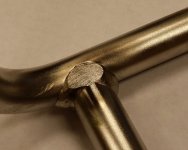Sodo
Elite Member
- Joined
- Apr 21, 2012
- Messages
- 3,197
- Location
- Cascade Mtns of WA state
- Tractor
- Kubota B-series & Mini Excavator
I need to grind weld protrusions off 30 items that are "for sale" (60 grinds). I want to passivate just that one grind spot so it doesn't leak rust onto visible parts. The grind area is about 1/4" x 1/2", and it's on the underside so not visible.
Does anybody know an easy trick to get a small amount of phosphoric acid. I can order a whole quart of it but I don't want to store the remaining 99% of the quart, and I don't want to discard it either. I want just a little bit (and soon). Does anybody know of readily available products containing phosphoric acid?
Here's a pic of the grinded area, and it's been wire-wheel'd with a stainless brush. Thanks!

Does anybody know an easy trick to get a small amount of phosphoric acid. I can order a whole quart of it but I don't want to store the remaining 99% of the quart, and I don't want to discard it either. I want just a little bit (and soon). Does anybody know of readily available products containing phosphoric acid?
Here's a pic of the grinded area, and it's been wire-wheel'd with a stainless brush. Thanks!
